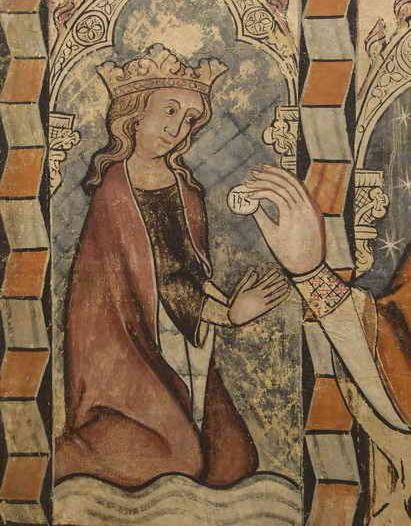Tenure 1377–1387 Father Berenguer de Fortia | Mother Francesca of Palau Name Sibila Fortia | |
 | ||
Coronation January 1381 (Zaragoza) Burial San Francisco (Framenors)
Pantheon of Poblet
Cathedral of Barcelona Issue Isabella, Countess of Urgel Died November 24, 1406, Barcelona, Spain Spouse Peter IV of Aragon (m. 1377–1387) Children Isabella of Aragon, Countess of Urgell Grandchildren Isabella of Urgell, Duchess of Coimbra Great grandchildren Isabella of Coimbra, James of Portugal Similar People Peter IV of Aragon, John I of Aragon, Martin of Aragon, Alfonso IV of Aragon | ||
Sibila of Fortià (died 1406), Queen of Aragon, was daughter of Berenguer de Fortià and his wife Francesca of Palau. Sibila belonged to the family of Fortià, of the lower nobility, with possessions in rural Empordà, in the county of Ampurias. She was the fourth wife of Peter IV of Aragon.
Contents
Early life
Sibila was said to be a natural beauty in her early adulthood. She married her first husband, Artal de Foces on an unknown date. Upon her widowhood, Sibila became a lady in waiting to Peter's third wife, Eleanor of Sicily, during the royal couple's stay in Sibila's home of Empordà. Eleanor died in 1375; she had left Peter two surviving sons and one daughter.
Sibila attracted the attention of the king soon after Eleanor's death, when Sibila was in her twenties and Peter was fifty six. When the king's sons, Martin and John, found out what was happening, they opposed their father's remarriage, as it could cause dynastic problems. The marriage announcement of the lovers led to tense relations between the king and his sons.
Second marriage: Queen of Aragon
On 11 October 1377, in Barcelona, Sibila married Peter IV of Aragon, becoming his fourth wife. It's believed that before the marriage, Sibila gave birth to a son, Alfonso, who only lived for a year. The child's birth has been doubted, as the only record of his birth is in the Chronicle of Peter IV of Aragon.
The couple had three children:
Over time, things grew worse. Sibila's family were invited to court, and the king began to favor Sibila's brother, Bernard. Peter, Sibila and her family formed one faction of the court, the other being composed of Peter's son and heir, John, his French wife Violante de Bar, and their followers.
Widowhood
After Peter died in 1387, John and Violant became King and Queen of Aragon, and they wanted rid of Sibila. For her own safety, Sibila fled to Sant Martí Sarroca; where her stepdaughter, Eleanor of Aragon had lived before her death. Sibila did not stay there long, as she was forced to return to Aragon, on the command of John and Violant.
They did not execute Sibila but sent her to live in Barcelona under close surveillance, however she was treated better there than at the royal court. After John died in 1396, and Martin succeeded him, Sibila remained in Barcelona.
Death and burial
Sibila died in Barcelona on 24 November 1406. By order of King Martin she had a state funeral. She was buried in the convent of San Francisco (Framenors) in Barcelona, traditional burial place of kings and queens of Aragon. She was later transferred to the pantheon of Poblet.
When the convent was demolished in the nineteenth century, Sibila and others were reburied on 20 April 1852 at the Cathedral of Barcelona. She was the first deposited in a box embedded in the wall of the chapel of the Martyrs of the cloister, covered by Isabella II of Spain, and on 13 October 1998, moved inside the temple, in a box placed on the wall to the left of the altar major.
